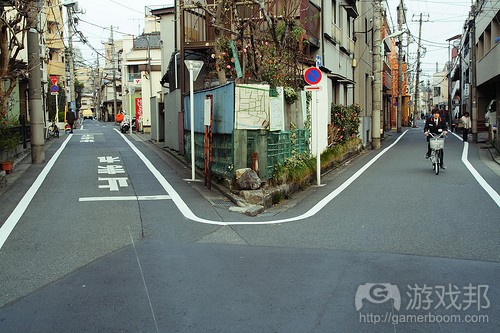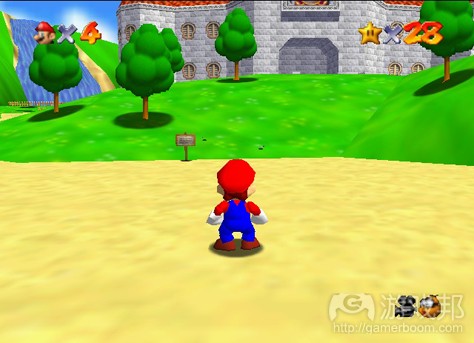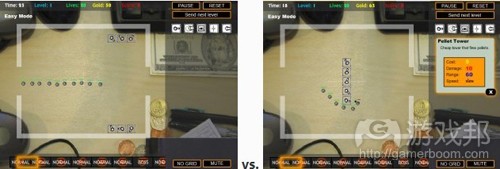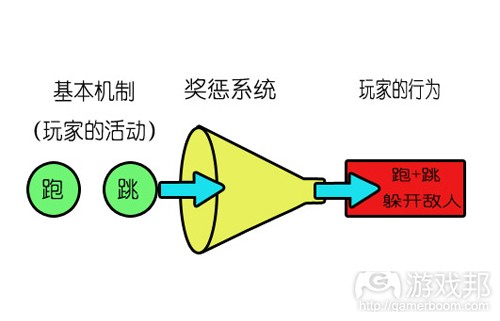解析游戏设计策略之奖惩系统
作者:Brice Morrison
我们的日常生活充满了选择。睡眼朦胧中听到闹钟作响,鲤鱼打挺跳起来还是摁掉闹钟继续睡?今天的晚饭是吃鸡、啃牛排还是吃素好呢?埋头工作还是和朋友外出玩?这些选择就像一盒颜料,你用不同的色彩描绘每天的生活、工作仍至生命。正是通过这些选择,你体验自己的存在、向世界表达自己的存在。
如果人生是一场游戏,那么做这些选择的活动就是人生的基础机制,你有选择、有能力做或不做。这些行为就像生活的变量,你可以把它们输入生活这个系统。总之,无论是什么行动,只要在你的能力范围以内,你就可以随心所欲地做选择。
真的可以这样吗?当然不可以。现实可没有你想象的那么自由。确实,你有选择权,但有选择就有相应的后果、要求和规矩。在人生这场游戏里,你也许有能力冲进图书馆大声喧哗。你可能有能力侮辱最好的朋友或打劫便利店。你大约有能力沮丧地宅在公寓,不与朋友欢度周末。
以上都是你的选择,但你可能不会这么做。即使你有能力有办法去实施,还是受到其他指导性条件的约束。所谓“选择”的内涵远比你想象的要深刻。你的决定仿佛受到一股超脱于自身的无形力量的主宰。
奖惩系统影响玩家的行为
正如上面所讨论的那样,游戏为玩家提供了各种选择。玩家可以跑、射、画、投、吃、躲、攻、瞬间移动等等等。但这些行为都不是孤立存在的,总是有一个更高级的系统——奖惩系统统领这些行为,促使玩家从中做选择。奖惩系统同时赋予了基础机制以意义和份量,迫使玩家慎重考虑自己的选择。
因此,理解游戏设计中的奖惩系统是明白人类行为的重要课题。在特定的时刻,人的选择范围是很广的,然而,最普遍的行为只占了其中很小的比例。原因就是我们上面提到的,有什么样的选择就有什么样的结果。无论是在现实生活还是游戏世界,人们都是从过去的经验中学习,然后根据预期的最理想的结果来选择当前行为。行为与结果的对应关系组成了主宰玩家行为的奖惩系统。
在搞清楚奖惩系统是怎么一回事以前,我们先举一个简单的例子。在《超级马里奥64》中,游戏的基本机制就是跑跑跳跳着通过各个台面(暂不考虑战斗和能量源)。怎么使用这些能力一边前进一边收集通关所需的星星取决于玩家本人。
然而,玩家控制马里奥的行为要受到游戏奖惩系统的约束。如果马里奥撞到敌人,那么他就会挂掉一条命。这是一种简单的惩罚,从中我们可以看出这个系统是如何影响玩家的行为,这种影响远比我们所想象的要深刻。一旦玩家明白撞上蘑菇头就会损失一条命,那么他们的行为就会改变,不会像当初那么横冲直撞了。这就是惩罚的意义所在。
接下来,马里奥继续跑着,又遇到蘑菇头了。从技术上来说,玩家的行为中确实还存在一头撞向蘑菇头的选项,但游戏的奖惩系统已经告诉玩家此时应该躲避。因此,玩家会选择操纵马里奥躲开蘑菇头。
现在你看出什么来没?游戏的基本机制没变,仍旧是马里奥的跑跑跳跳,但玩家的行为改变了。玩家对游戏系统“心领神会”后,他们的决定随之改变。
随着玩家与游戏及其奖惩系统的互动进一步加强,玩家开始形成心智模型——系统的运作原理和行动的最佳方案。玩家能否完全理解系统取决于玩家自身,而奖惩系统的工作就是激发玩家的理想行为。一个好的游戏设计能够反映出玩家的理想行为,然后围绕理想行为构建奖惩系统,从而鼓励玩家做出理想的行为决定。
策略
在马里奥和蘑菇头的例子中,奖惩系统的作用相当明显,但并不是所有时候都那么直接。我们再以塔防游戏为例。在塔防游戏中,玩家必须建防御塔来阻止敌人抵达游戏屏幕的另一边。当敌人经过时,这些塔就会发动攻击,敌人走的总是抵达目标的最短路线。
塔防类游戏的基本机制是:
1、决定设置什么塔(游戏邦注:例如攻击力高低或成本高低等)
2、决定建塔的位置(2D平面)
以上就是玩家要做的选择,具体怎么做还是由玩家说的算,对吧?
如果你有认真看前面的内容的话,你应该知道当然不对。还是从技术上讲,玩家把塔丢哪都行,如果他已经不在乎输赢。游戏的奖惩系统鼓励特定的行为,所以实际上,玩家的选择就是游戏设定好的那种机制。
例如,玩家可以把塔远远地放在右上角,但奖惩系统可不太鼓励。这么做的直接后果就是火力不足,敌人迅速“上位”,玩家失败。最终,玩家会意识到最佳方案是把塔放在中间,这样基本上就完美地阻断了敌人的前进道路。当然玩家也可以继续顽固地把塔放在角落,输了再放,放了再输,不过,老输的游戏还有啥意思呢。
这又是一个奖惩系统决定玩家行为的例子。游戏给玩家一定的选择,但玩家胜利的条件是实施隐藏在系统之后的最佳策略。
奖惩系统的基本原则
奖惩系统怎么作用于玩家的行为?请看以下模式图:
开发者通过基本机制决定玩家的行为。然后,开发者设计奖惩系统来过滤玩家的可能选择,最后形成的是理想的玩家行为。
那么,这种奖惩系统是怎么设计出来的呢?答案就是,先给自己充点行为心理学的电。这门学问的先驱研究者是B.F. Skinner等行为学家,特别是他提出的操作性条件作用(条件反射理论),是观察主体对某种系统的作出反应的行为。
似曾相识?操作性条件作用就是我在本文中所探讨的问题的研究基础。与操作性行为作用相似,游戏中的奖惩系统影响玩家的行为,主要采取以下四种方式:
1、主动奖励:以玩家想要或喜欢的东西作为对玩家行为的奖励。
2、被动奖励:移除玩家不喜欢的东西作为对玩家行为的奖励。
3、主动惩罚:给予玩家不想要或不喜欢的东西作为对玩家行为的惩罚。
4、被动惩罚:移除玩家想要的或喜欢的东西作为对玩家行为的惩罚。
根据玩家对基本机制的运用,游戏给予玩家奖励或惩罚,这样,游戏开发者得以不断修整基本机制的运用。例如,在《超级马里奥64》中,当玩家打败敌人,玩家通常会得到渴求的金币。这就是主动奖励。另外,蘑菇头没了,也就是说玩家在这道关卡的敌人减少了,这是被动奖励。
对于奖罚系统的惩罚方面,如果马里奥掉到火山岩浆里,那么他就得哀号着、失控般地扑灭工装裤上的火焰。这是主动惩罚,即给予玩家不想要的东西——玩家希望始终把对马里奥的控制权掌握在自己手里,而不是任马里奥自己乱来。另外,马里奥损失生命,这是被动惩罚,因为玩家希望命越多越好。
玩家行为塑造法
一开始,游戏的机制又少又简单,后来,不仅数量增加了,复杂程度也随着游戏进展呈螺旋式上升,然后奖惩系统开始变得相当复杂。因此,为了促成理想的玩家行为,清楚地理解设计奖惩系统的基本策略是非常必要的。
再者,所有一切总是从游戏设计的核心体验部分开始。一旦你定义好游戏的核心体验,那么就可以开始设计能够触发理想行为的机制了。在此,请考虑以下普遍原则:
描述理想行为。好的奖惩系统是隐蔽的。大多数开发者倾向于把注意力放在他们希望的行为上,然后设计能够激发那些行为的系统。如果只是关注这个系统本身,可能会产生混乱,最终导致失败。所以你得详尽地描述理想的玩家行为。然后围绕你的描述构建奖惩系统。试着站在玩家的立场来想象你的行为。
调整。如果你所设计的系统没有激发玩家的理想行为,那么你可以进一步调整。当你希望玩家迅速地越过墙时,你想象过(或在做原型时看过)玩家总是撞到墙上的情形吗?这时,你要做的就是稍微惩罚一下玩家的撞墙行为。一点小小的调整可以对玩家的行为产生重大影响。另外,请保证观看你的原型视频,然后再研究如何让游戏激发玩家的理想行为。
反馈时间。另一个要考虑到的重点是奖惩的反馈时间是多少?时间多长你说了算,但你得根据希望玩家如何学习游戏的固有系统来做决定。在大部分游戏中,如《超级马里奥》,反馈是立即的。“我从悬崖上摔下来,游戏马上宣布我死亡。好吧,收到。真惨,别再摔了。”
然而,在其他游戏中,通过延迟给予奖惩反馈,可以增加机制的复杂度。在策略游戏中,如《星际争霸》,玩家需要花更多时间来掌握策略,因为成败的反馈只到最后才知道。比如,玩家在一个难以防守的地点建立基地可能只需要五分钟,但这个选择导致的失败直到一个小时后才出现。但玩家不可能立马就把失败和建立基地的地点联系起来。行为和反馈的循环所需时间越长,玩家越难以有意识地发现其中的关系。
好的奖惩系统会让玩家产生掌握了游戏核心体验的满足感。无论是从巨龟怪那里救下公主还是打败迎面而来的敌人军队,奖惩系统可以指导玩家采取什么行动。另一方面,失败的奖惩系统会拖游戏的后腿,让游戏看起来像是粗糙的半成品。务必协调好游戏的奖励系统,这样才能给玩家带来畅快淋漓的游戏体验,且保持玩家所想和游戏所为之间的和谐。
游戏邦注:原文发表于2009年,所涉数据及时间均以此为准。(本文为游戏邦/gamerboom.com编译,拒绝任何不保留版权的转载,如需转载请联系:游戏邦)
The Game Design Canvas: Punishment and Reward System
by Brice Morrison
You have many choices in your everyday life. Wake up and jump out of bed, or hit the snooze button? Eat chicken, beef, or veggies? Do some work, or go out with friends? These choices, these actions that you can take are the different colors you use to paint the landscape of your day, your week, and your life. It is through these choices that you experience and express yourself in the world.
If life were a game, these actions that you can take are examples of the Base Mechanics of life. They are actions that you can perform, that you have the ability to perform, and that you may choose or choose not to perform. They are the inputs into the system from yourself. You can freely choose from all the possible abilities you have and perform them to your liking.
…Or can you? Well, there’s more to it than that. Your actions and free will are not as free as one would think. Yes, you have choices you can make, but there are consequences, there are requirements, and there are strings attached. You may have the ability to go into the middle of a library and shout at the top of your lungs.
You may have the ability to insult your best friend or to rob a convenience store. You may have the ability to sit in your apartment and be depressed instead of going out and enjoying the weekend with friends.
You could do these things, but you probably won’t. Even though you have the ability and the means, there is something else that is guiding your decisions. There is more to this so called “choice” business than you might imagine. It is as though some invisible force outside of yourself is governing your actions.
Free Will? Or Not So Free?
As we discussed in our last introductory article to the game design canvas on Base Mechanics, every game has actions that it lets the player perform. The player can run, shoot, paint, throw, eat, duck, swap polarity, teleport, or what have you. But these actions are not isolated; they have higher systems that govern them. These Punishment and Reward Systems nudge the player towards certain behavior. They give meaning and weight to the Base Mechanics, forcing the player to think about their choices.
Thus, understanding the Punishment and Rewards System section of the Game Design Canvas is a lesson in understanding human behavior. It would appear that humans have an incredible range of actions they can make at any given moment, yet the most common behavior is but a small percentage of all of those actions. The reason for this is, as we said, is that games couple their actions with consequences. In life and in games, people learn from their past experiences and then choose from among their desired consequences to choose their actions. These couplings of action and consequences make up the Punishment and Reward Systems that govern player behavior.
Death by henchmen? I’ll pass.
To begin to understand Punishment and Reward Systems, let’s start simple and work our way up. In Super Mario 64, the player’s Base Mechanics allow them to run and jump through each stage (ignoring punching and power-ups for a moment). It’s up to the player to decide how to use those abilities to navigate the world and collect the stars needed to complete the stage.
However, the player’s actions when controlling Mario are constrained by the game’s P&R Systems. If Mario is touched by an enemy, then he falls to the ground and loses of health. This is a simple example of Punishment, and we can analyze this System to see how it affects player behavior, because the effects are more far-reaching than one would imagine. Once the player understands that smacking into a Goomba will result in damaging Mario, their behavior will change. And that is where it gets interesting.
So Mario is running along, and the player sees a Goomba. Technically, the player does have the choice of running headlong into the Goomba. However, the game’s P&R System has taught them that this is something that should be avoided. Thus, the player steers Mario around the Goomba to avoid him.
Do you see what’s happened here? The game made no changes to the Base Mechanics: they were still just running and jumping. But they way that the player used these Mechanics has been changed. After the player learned what the game was encouraging them to do, the decisions they made were altered.
As players interact with a game and its P&R Systems, they begin to make a mental model in their mind of how the System works, and how they can best navigate it.
Whether or not the developer wants the player to fully understand the system is up to them, but the job of the P&R System is to evoke the desired player behavior. A good design will be able to plot out the player’s desired behavior and then build a P&R System around that to encourage that very behavior.
Planting The Seeds of Strategy
Mario and the Goomba was an obvious example, but sometimes the effects of a P&R system will be more latent. Let’s take for example the popular tower-defense genre.
In these games, the player needs to erect offensive towers to keep the enemy army from reaching the other side of the screen. These towers attack the enemies as they walk by, and the enemies attempt to find the shortest path to their goal.
In these games, the Base Mechanics are:
? Deciding which towers to place (usually weaker vs. stronger but more expensive, etc.)
? Deciding where to place the towers (usually on a 2D plane)
Those are the choices that the player has before them, and they can execute these Mechanics however they like, right?
If you’ve been paying attention, hopefully you’ve learned by now that this is not exactly the case. Technically, yes, the player can place whatever towers wherever they like, but they are likely to lose. The game’s P&R Systems will encourage certain behavior. So in actuality, the player can only use the Mechanics in ways designed by the game.
For example, the player can put a tower in the top right corner, far away from everything else, but the P&R Systems discourage this. The enemies will not be fired upon as much, and they will likely make it to their goal, causing the player to lose. Eventually, the player will learn that the best choice is to place the towers in the middle, ideally in a way that blocks the enemies. Of course the player could continue placing the towers in the corner, losing, and doing it over again, but that gets very boring very quickly.
Again, this is an example of the Punishment and Reward Systems shaping the player’s behavior. The game gives the player certain actions to perform, but hidden within the System is an optimal strategy if the player wants to succeed.
Fundamental Rules of P&R Systems
A good way to think about how P&R Systems affect player behavior is with the following diagram:
The developer decides what actions to give to the player via the Base Mechanics. Then, the developer constructs the P&R System to funnel the player’s possible choices into the desired player behavior.
So how does one go about constructing such an interesting funnel? To answer that, we need to visit one of the great influences to game design: behaviorist psychology. Pioneered by researchers such as B.F. Skinner, behaviorism, specifically operant conditioning, was a way of viewing a subject’s behavior in terms of their actions and the system’s responses.
Sound familiar? Operant conditioning is the foundational field of research that ties in very closely with what we’ve discussed so far in games. Similarly to operant condition in behaviorism, Punishment and Reward Systems in the Game Design Canvas have four main ways to affect a player’s behavior:
1. Positive Reward – Rewarding the player’s behavior by giving them something they want or like.
2. Negative Reward – Rewarding the player by taking away something they didn’t like.
3. Positive Punishment – Punishing the player’s behavior by giving them something they don’t want or like.
4. Negative Punishment – Punishing the player by taking away something the wanted or liked.
By tying Rewards and Punishments to the player’s use of the game’s Base Mechanics, the game developer shapes their use. For example, in Super Mario 64, when the player defeats a koopa troopa enemy, then they player often receive a coin, which is something they want. This is an example of a positive reward. Additionally, the Goomba is now gone, which is an example of a negative reward, since there are less enemies on the level who could harm you.
For the Punishment side of the P&R System, if Mario falls into the lava, then he begins to wail and dash around uncontrollably, trying to put out the flames on his overalls. This running around is an example of positive punishment, giving the player some behavior that they don’t want — they want to be able to guide Mario, not have to steer him wildly! Additionally, the Mario loses some life when he falls in the lava, this is an example of negative punishment, since the player wants to have as many life bars as possible.
Guidelines for Sculpting Player Behavior
As a game grows from a few simple mechanics to dozens or more, and the complexity of the game itself spirals upwards into hours and hours of gameplay, then the Punishment and Reward Systems will begin to get rather complicated. Thus, good to have a clear understanding of the basic strategies for constructing one in order to get desired player behavior.
Once again, everything always begins with the Core Experience portion of the Game Design Canvas. Once you have the Core Experience of your game defined, then you can begin plotting out your mechanics, which leads to your desired player behavior. Think about following these general guidelines:
Making a first guess. A good P&R System is designed indirectly. Most developers prefer to focus on the behavior they want, then they set up the system to evoke that system, not the other way around. Focusing on the system itself can be confusing and lead to dead ends. So plot out how you’d like your player to act, describing it in detail. Then set up Punishment and Reward Systems around that to encourage that behavior. Try to put yourself in the player’s shoes and imagine what you’d do.
Slight changes and tweaking. If the system you’ve designed doesn’t result in the player behavior you want, then you can tweak it. Do you imagine (or see, if you’re prototyping) players always bumping into walls when you wanted them to swing swiftly through the stage? Then create a light punishment for bumping into walls.
Small changes can make big results in terms of player behavior. Also, be sure to watch our video on playtesting to learn how you can alter your game to achieve the desired player behavior.
Timing the feedback. Another important aspect to think about is how long it takes for the P&R feedback to reach the player. The amount of time you decide for this is up to you, but it depends on exactly how you want the player to be learning the systems inherent in your game. In most games like Super Mario, the feedback is instantaneous. ”I fell off a cliff and the game told me I died. Ok, got it. That is bad. Next time, don’t fall off a cliff.”
However, in other games, complexity is added by not giving the P&R feedback immediately. In strategy games like Starcraft, it takes much longer for players to master strategies, because the feedback of a won or lost match may not come until long after the dooming action. A player may build a base in a difficult-to-defend spot 5 minutes into the game, and that choice may lead to the player’s downfall an hour later. However, it’s unlikely that the player will make this immediate connection.
The longer the loop between action and feedback, the more focused time it will take for the player to consciously understand.
Reward them with a Great Game
A good Punishment and Reward System will allow players to feel the satisfaction of mastering your game’s Core Experience. Whether it’s to save the princess for a giant turtle or to defeat the incoming onslaught of alien armies, P&R can act as guideposts to help the player learn what to do. On other hand, slopping P&R Systems make for a game that feels like it’s unpolished and has no real destination. Making the commitment to fine tune the game’s rewards and carrots for the player will result in a smoother experience and a harmony between what the player wants to do and what the game was designed to do.(source:thegameprodigy)
上一篇:Laralyn McWilliams称用户需求是游戏设计的关键
下一篇:分析游戏设计标准之美学布局











































 闽公网安备35020302001549号
闽公网安备35020302001549号